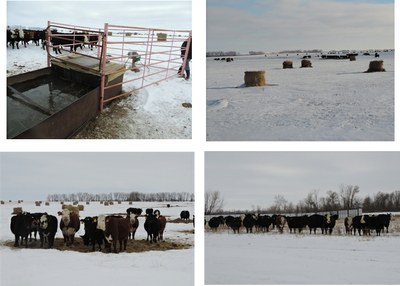Adoptions of Bale Grazing
Adoptions of Bale Grazing in North Dakota
John Dhuyvetter, NCREC Area Livestock Specialist
Winter feeding practices vary considerably between beef cow operations and continually evolve in response to labor, technology, costs and other influencing factors.
Corn silage has been gaining popularity as a harvested feed. The ability to put up large quantities of high quality feed relatively fast on limited land base can be achieved. In spite of high production and harvest costs, it is a competitive source of nutrients, when high yields can be achieved, and it can be utilized in combination with low cost roughages. Feeding requires some added equipment as a mixer and second tractor.
The use of a bale shredder to deliver processed hay into windrows has grown substantially. As herds have been moved away from the corral and farmstead to winter feed on adjacent fields, the processed forage minimizes feeding waste of coarse forages and residue and the facilitates ease of subsequent farming operations. Processing into long uniform windrows also offers advantages to equalizing feed and ration opportunities for mixed age cattle and for timid animals lower in the pecking order.
There are some operations more uniquely positioned to harvest and feed very little forage. They feed just small quantity supplements in combination with off season grazing. This can be seen as stockpiled winter range and cake operations, corn stalks and distillers or diverse full season forage-cover crop allocated out for fall and winter grazing.
Adjusting to the BSE market crash, our Canadian neighbors out of necessity made changes to cut costs for survival. This exposed North Dakotans to practices as residue bunching, corn grazing, swath grazing and bale grazing which were being utilized. Initial reactions to bale grazing were that most of the cost is already incurred in producing and making the hay, so the cost savings in feeding it wouldn’t be worth expectations for considerable waste and loss.
Now years later we see operations where bale grazing has been successfully adopted as a winter feeding method in the state with a variety of variations to accommodate the needs and situations. Bale grazing can provide economic and environmental benefits. Where daily labor is not available, feeding time can be allocated over multiple days as weekly. Tractor use can be greatly minimized in situations with fall planning and fencing. Left over manure and hay residue is a great for improvement of land on which bale grazing was done.
An ideal situation might be where productive hay lands are watered, fenced, accessible and sisal tied bales can be grazed where they were made. By use of temporary fencing the field can be split into small paddocks of enough bales needed to meet cow’s needs for about a week. Cows would be given access to another paddock of bales when they had cleaned up the first. This system eliminates all the cost of hauling in hay, feeding hay, and hauling manure. Further it helps maintain hay land productivity through nutrient cycling rather than export.
Some early bale grazing programs involved moving hay from hay lands to a winter site with access to wind protection and winter water. Bales were placed in a 40’ grid pattern and the net wrap or twine removed. Based on projected bale weight and expected cow intake (about 40 pound/day) a row of bales is electric fenced off to feed cows for the desired time period. If the hay supply included different qualities of hay, the grid pattern should allocate a mix of good and poor bales. Waste of the high quality hay would be minimal. Some leftover build-up of poor roughage can be expected but would relate to little cost.
From a practical standpoint, bale grazing can be utilized by setting out a multiple day allotment of bales when time is not available to daily feed. For someone working off the farm this might be watching the forecast, estimating cow consumption and setting out enough bales on the weekend for the entire week. Preferably bale grazing shoul d be done on a tame grass sod sites with limited risk of runoff.
d be done on a tame grass sod sites with limited risk of runoff.
Experience has shown us, winter water and wind shelter are necessary for cow performance. More extensive feeding systems with cows out and away from corrals and barns are best suited to later calving dates. Attention to cow performance and condition is important, with extra care given to thin cows. Hay quality and mineral supplementation are still important to meeting cow’s needs. Where net wrap is left on the bales, a follow up effort is needed to clean up the feeding field. As a successful bale grazer has said, “Your success with the practice depends on whether you want it to work or not”.

